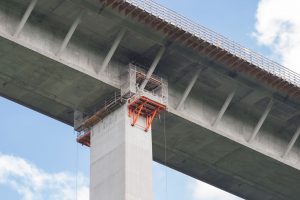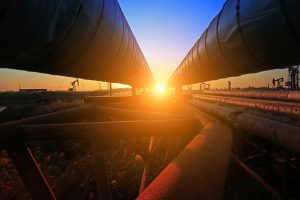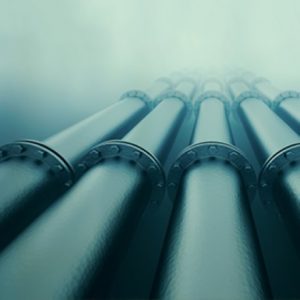In December 2019, the United States introduced sanctions against companies involved in the construction of the Russian gas pipeline projects Nord Stream 2 and Turk Stream. As a result, Swiss company Allseas, that has been installing the underwater pipeline for Nord Stream 2 in Danish territorial waters, paused its work. This resulted in a significant delay in the project’s completion, even though at the time of the announcement, approximately 93 per cent of Nord Stream 2 had been finished, according to Russian newspaper “Vedomosti”.
The Nord Stream 2 gas pipeline was developed by Russian company Gazprom to deliver natural gas to Germany through the Baltic sea bypassing transit pipelines that go through Ukraine, Belarus, Poland and other East European and Baltic states. With a length of 1,224 kilometers, the Nord Stream 2 pipeline is sized to deliver up to 55 billion cubic meters of natural gas per year from Russia to Europe.
The project is a joint venture between Gazprom, Austrian OMV, French Engie, British-Dutch Shell and the German firms Wintershall and Uniper. Originally, commissioning of the project was planned at the end of 2019. After the U.S. sanctions, Gazprom indicated that the project will be completed solely by Russian engineering and construction companies. According to Russian officials, shipments through Nord Stream 2 could come as early as of the end of this year.
Despite the substantial investments by Gazprom and its partners (Gazprom invested about $5 billion USD), the project is facing serious economic challenges. Even though European gas demand is expected to grow in the long-term, the projected increase from 2020 to 2030 is not high and reaches only 9.6 per cent for the 10 years.
At the same time, a significant increase in the global supply of LNG puts pressure on the price of the commodity in Europe and, also, on the price of Russian pipeline gas. The Natural Gas Programme of the Oxford Institute for Energy Studies recently published a report that estimates: “European gas demand will not recover to its 2010 level until about 2025… The natural gas demand in the 35 countries of the European region falls from 594 billion cubic meters in 2010 to 564 billion cubic meters in 2020 and then rises to 618 billion cubic meters in 2030”.
Currently, total capacity of LNG terminals in Europe (including Turkey) exceeds 160 million tonnes. In addition, Germany, Croatia, Estonia and Cyprus are planning to build new terminals with a total capacity of about 30 million tonnes.
Due to the newly developed LNG infrastructure and growing supply, European customers purchased around 110 billion cubic meters of LNG in 2019, as estimated by the EIA (US Energy Information Administration). This was approximately double the volume of LNG purchased by Europe in the previous year.
At the beginning of 2020, the amount of LNG supplied to the region equaled the volume of gas transported through pipelines. The success of LNG is resulting from the fact that it is cheaper than pipeline gas if transportation exceeds four thousand kilometers.
The ongoing economic slowdown in Asia and the commissioning of new LNG projects around the world resulted in a major decrease of global LNG and pipeline gas prices. The average price of Russian pipeline gas sold in Europe in 2018 was around $246 USD per thousand cubic meters. In Q3 2019, the price dropped dramatically (by about 31 per cent) to approximately $170 USD per thousand cubic meters.
In addition to lower prices, the structure of gas payments has changed as well. Historically, pipeline gas has been sold based on tariffs defined in long-term contracts, with contracts often designed around a “take-or-pay” approach (which guarantees a seller a minimum payment). Following the recent market developments, Gazprom started to sell more gas on the spot market (approximately 16.5 per cent as of January 2020). The change in the sales approach from the contract base to spot prices increases the overall risk to suppliers and raises the cost of capital for their new projects.
The major exporters of LNG in the world include Australia, Qatar and the United States, with the U.S. quickly ramping up LNG production despite the supply glut resulting from the economic slowdown in Asia. Intentions to build large LNG-related infrastructure projects have been manifested by many energy companies, such as Shell and Total, as well as some large utilities. However, according to McKinsey consultants, only 10 per cent of these projects are likely to be implemented, as potential global supply seems to exceed demand.
Slow long-term growth in European gas demand, fast development of new LNG infrastructure, as well as the pressure on gas prices that is likely to increase even further due to the global economic growth slowdown, undermine the importance of the immediate completion of Nord Stream 2.
In addition, a recently signed five-year contract for pipeline gas transportation between Russia and Ukraine (planned transportation: 65 billion cubic meters in 2020 and 40 billion cubic meters annually for the next four years) significantly lowers risks related to Russian gas supply to Europe in the long-term and highlights a need for alternative pipeline gas delivery projects.
Dmytro Konovalov has over 10 years of experience in equity research and analysis for global markets at leading international financial institutions.











Well, if transporting LNG is cheaper than a pipeline after 4,000 kilometers then they should always take the longer way around.